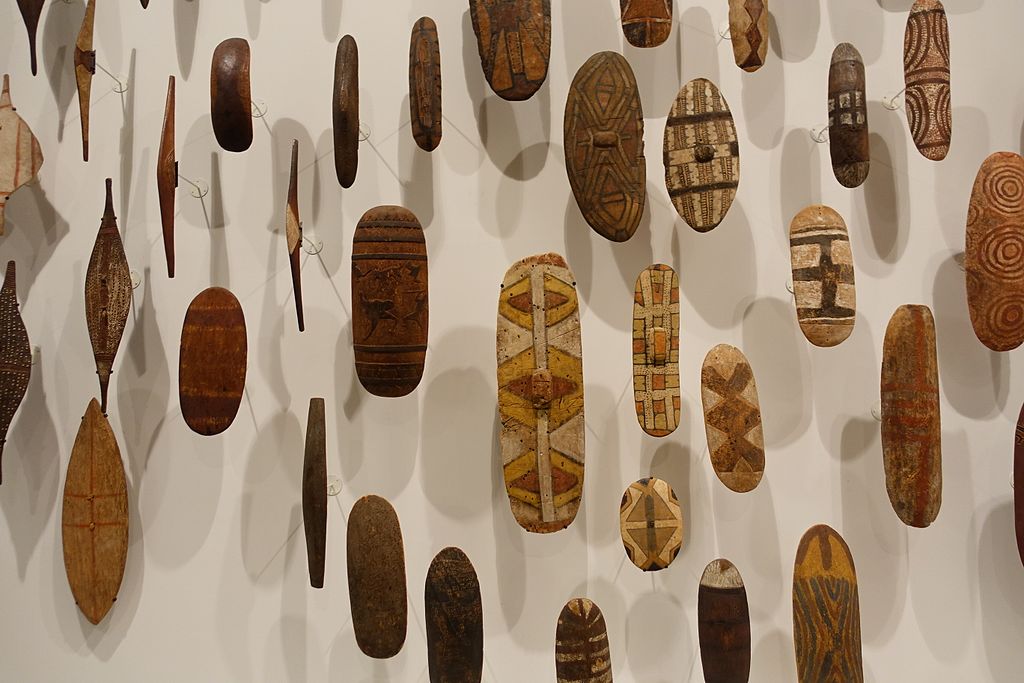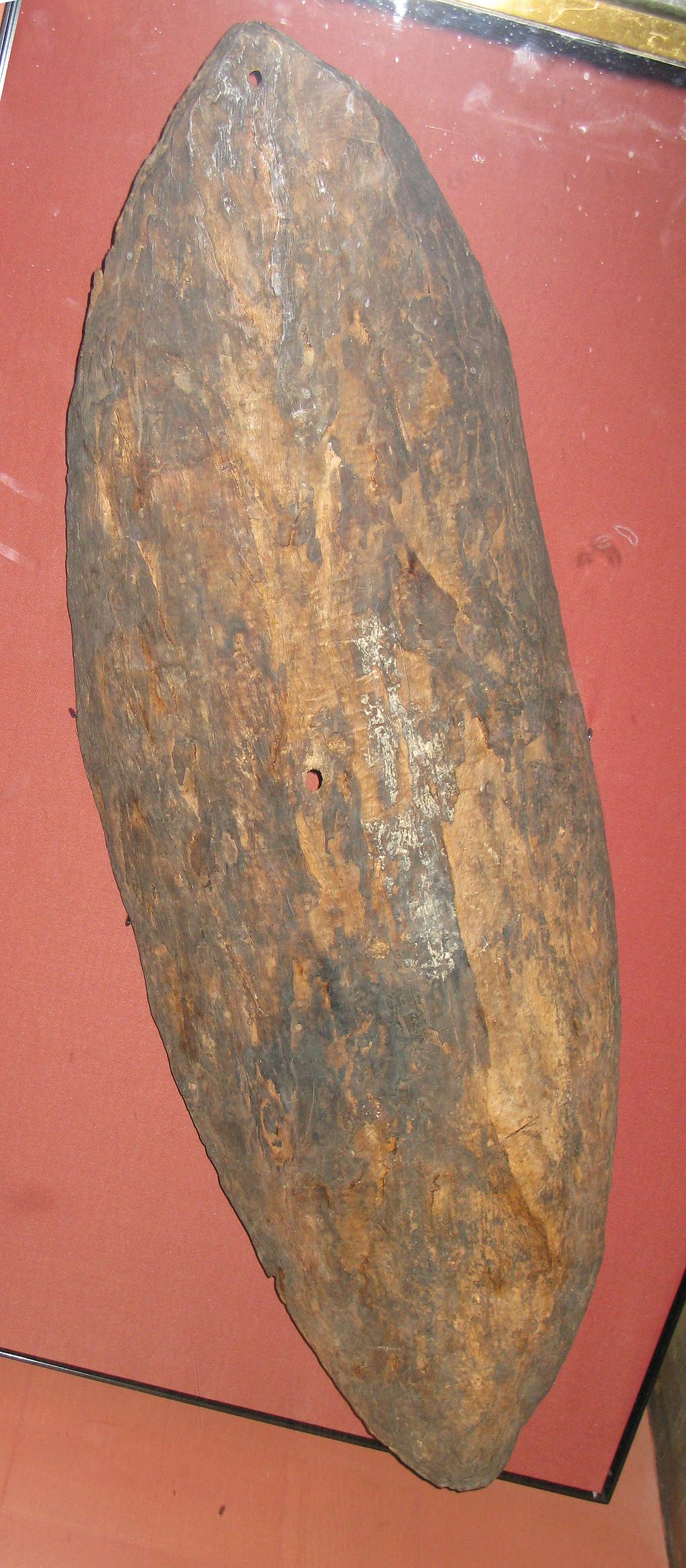
These Australian Aboriginal shields are made from wood, cane, feathers, and earth pigments. Most of these shields come from the south-eastern regions of Australia.
For Aboriginal societies, these shields were unique objects of power and prestige. Unfortunately, much of their ownership, history, and iconography have been lost.
The Aboriginal people existed in Australia and surrounding islands before European colonization going back in time to between 61,000 and 125,000 years ago. T
he trauma of loss that followed the establishment of a British colony in Australia had an enormously adverse effect on the indigenous Aboriginal People.
The widespread loss of language, culture, and tradition changed aboriginal life and their art culture.

Some of these shields would have been used during the conflict with colonial settlers and tribal disputes.
They would have been used to protect warriors against spears in staged battles or clubs in close fighting during contests for water, territory, and women.
These shields would have also been used during a culturally significant occasion, such as in corroborees. Corroborees are Australian Aboriginal dance ceremonies, which may take the form of a sacred ritual or an informal gathering.
These shields were often used in dances at ceremonies or traded as valuable cultural objects.
The shield collection also includes the narrow, wedge, or oval shields (pictured on the left below), which were used to ward off a weapon of attack with a counter move. The designs on the shields are all different, and no two are similar.

These shields were viewed as having their innate power. A shield that had “won many fights” was prized as an object of trade or honor.
First Contact and Conflict with Aborigines.
During the Aboriginal’s first encounter with Europeans, they would have used this leaf-like shaped shield below as their armor of battle.
The Eora people of Botany Bay in New South Wales were the first Aboriginal nation to encounter Captain James Cook on his voyage of British discovery to Australia in 1770.

First Aboriginal artifact captured by Captain Cook’s landing party in 1770
representing the first point of violent contact.
Now at the British Museum
This Australian Aboriginal bark shield from Botany Bay, New South Wales, Australia, has been identified as having been collected in 1770 on Captain Cook’s First Voyage in HMS Endeavour (1768-71). This shield is at the British Museum.
The hole in the center may have come from a musket bullet, fired by the British sailors against the aborigines, who then dropped this shield. History does not record what happened to that aborigine faced with this first alien contact.

Depictions of the first contact between the Aboriginal people and Captain James Cook and his crew
Aboriginal Shields
- Artifacts: Aboriginal Shields
- Dates: 18th and early 20th centuries
- Culture: Aboriginal Australia
- Location: South-eastern Australia
- Museum: National Gallery of Victoria – NGV
Aboriginal artifacts – message stick, boomerangs, spears, and spear throwers
Priceless indigenous shield ‘stolen’ by Captain Cook’s men
A Tour of the National Gallery of Victoria
- Aboriginal Shields
- “Endormies” by Rupert Bunny
- “Shearing the Rams” by Tom Roberts
- “The Purple Noon’s Transparent Might” by Arthur Streeton
- “The Pioneer” by Frederick McCubbin
- Early Australian Landscapes
- Head Covering of Padihorpasheraset
- “The Crossing of the Red Sea” by Nicolas Poussin
AUSTRALIAN WOODEN SHIELDS AND WEAPONS
Australian Aboriginal Sayings and Quotes~~~
“Traveler, there are no paths. Paths are made by walking.”
~~~
“Those who lose dreaming are lost.”
~~~
“We are all visitors to this time, this place. We are just passing through. Our purpose here is to see, to learn, to grow, to love, and then we return home.”
~~~
“The more you know, the less you need.”
~~~
“May as well be here, we are as where we are.”
~~~
“Keep your eyes on the sun, and you will not see the shadows.”
~~~
Aboriginal Shield
Brief Introduction to Australian Aboriginal Culture
~~~
“We are all visitors to this time, this place. We are just passing through.
Our purpose here is to see, to learn, to grow, to love, and then we return home.”
– Australian Aboriginal saying
~~~
Photo Credit: GM 2) By geni (Photo by user:geni) [GFDL (gnu.org/copyleft/fdl.html) or CC BY-SA 4.0-3.0-2.5-2.0-1.0 (creativecommons.org/licenses/by-sa/4.0-3.0-2.5-2.0-1.0)], via Wikimedia Commons 3) Public Domain, Link 4) By Walter Baldwin Spencer and Francis J Gillen – Photographers Details of artist on Google Art Project [Public domain or Public domain], via Wikimedia Commons
Popular this Week








 Sponsor your Favorite Page
Sponsor your Favorite Page SEARCH Search for: Search Follow UsJoin – The JOM Membership Program
Sponsor a Masterpiece with YOUR NAME CHOICE for $5
Share this:
- Tweet
